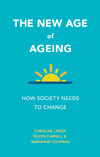This is my final week as guest blogger on this site. The focus this week is on older women in fiction from the UK. There are more than enough books to fill the days.
To introduce them I want to consider some of the ageist and sexist assumptions that shape how older women are represented in the UK, and then to provide you with examples that challenge the stereotypes and celebrate the diversity of older women.
Representing older women
There are social changes that need to be attended to as a result of the increase in the proportion of older people in the population. This was the subject of a book I wrote with two colleagues. It was called The New Age of Ageing: how society needs to change. We identified the toxic combination of ageism and sexism. We saw it in the media, or the absence of older women in the media, in language, in advertising of certain products and so on.
We found ageism in some political polemics about the greediness of the old who were blocking hospital beds, using the nation’s resources through the pensions and the National Health Service and retaining houses that are too large for them and thus contributing to the housing crisis.
I’m not going to argue these points, you can get hold of our book to read what we had to say about those claims. We did recommend some new approaches, not least more awareness of ageism and that combination of ageism and sexism. We argued for more age-integrated planning and for better representation of older women.
The New Age of Ageing by Caroline Lodge, Eileen Carnell and Marianne Coleman

The consequences of ageist representation
The dominant view of older people is that their lives are much smaller now they are older; physically they are in decline; they have outlived their usefulness. This is well summed up by Carole Vorderman who worked with SunLife on a recent report on ageing:
“The report shows that we’re bombarded with phrases and behaviours which imply that life after 50 must be awful and that it’s ‘downhill all the way’. That just isn’t true, but this nonsensical school of thought will continue unless we raise the profile of the impact this type of language can have.” [from Guardian newspaper report called Over a third of Britons admit Ageist behaviour in new study. 19.8.19]
This report, identifies that ageism is damaging for mental health, hastens the onset of dementia and shortens life expectancy. The language and behaviours are experienced regularly at work, on public transport and while shopping by 40% of people over 50.
Representing older women
There are some very positive different ways of representing women that need to be more widely known.
I mentioned the Sheffield project in a previous post in which women took photographs of themselves that broke conventional representational rules. You can see their work on the Look At Me. Images of Women and Ageing.
Have you come across the wonderful photography by Alex Rotas? I first saw her inspiring pictures of older athletes on Twitter. She says she is ‘on a mission to change how we view and experience older age’. Check out her website and images here.
And as stereotyping smooths away diversity, let us avoid the following assumptions:
Older women are primarily grandmothers. In the UK the media frequently refer to older women with the shorthand term granor granny. But many women are not grandmothers, and many of them are happy with that situation. Defining women by their relationship to grandchildren is very narrow.
Or older women are not sexual, or active, or have no role in society. One of the most important bits of research we found for our book was the economic value of all the volunteering carried out by older people: the care of dependents (sometimes even older dependants), formal volunteering in charities, and all the informal community volunteering.
Older women in fiction around the world
In this month’s guest blogathon on Global Literature in Libraries Initiative website, I am trying, as I do on my own blog, to promote strong, alternative, positive images of older women in fiction. If it is true that what you see is what you get (wysiwyg) then we need to spread these better representations more widely.
Week 4
In week 4 you will find these books that are from the UK:

Mrs Palfrey at the Claremont by Elizabeth Taylor
Moon Tiger by Penelope Lively
Elizabeth is Missing by Emma Healey
All Passion Spent by Vita Sackville-West
Great Granny Webster by Caroline Blackwood
Please make more suggestions of more older women in fiction around the world. I will report on these in one of my last posts. Meanwhile enjoy more these choices of older women in fiction from the UK.
Written and posted by Caroline Lodge of Bookword

I just finished Purge, by Sofi Oksanen, a Finnish-Estonian writer. In 1992, Aliide (older Estonian woman) finds Zara (young victim of trafficking) in front of her farmhouse. Both women’s pasts come to light over the course of the novel. And what are they each going to do now?
LikeLike
Thanks for this suggestion. Sounds like an interesting read.
Caroline
LikeLike